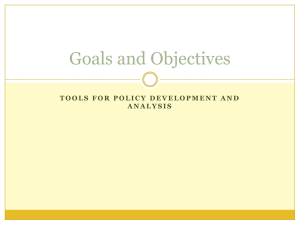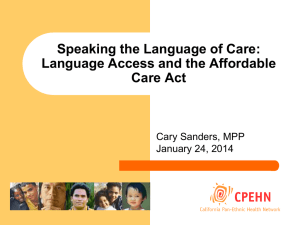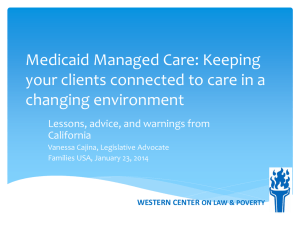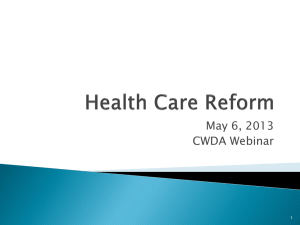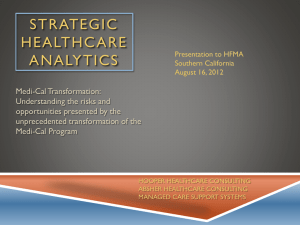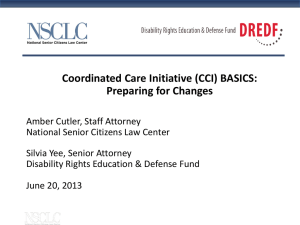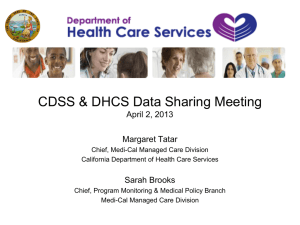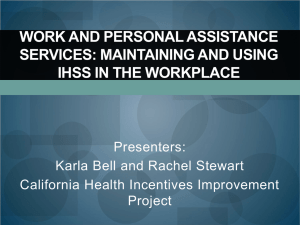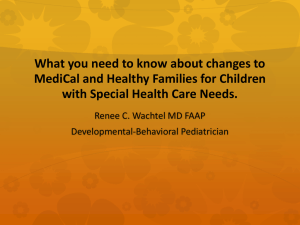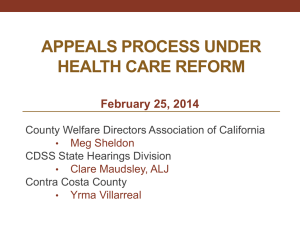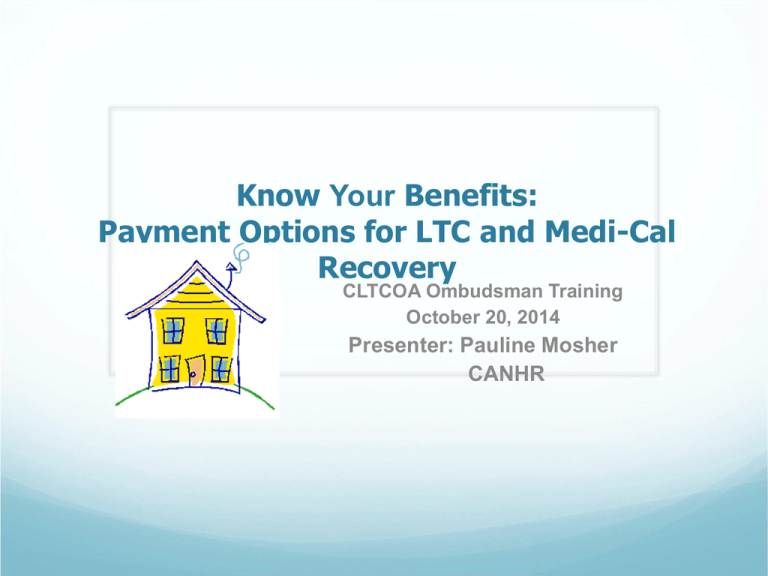
Know Your Benefits:
Payment Options for LTC and Medi-Cal
Recovery
CLTCOA Ombudsman Training
October 20, 2014
Presenter: Pauline Mosher
CANHR
California Advocates for
Nursing Home Reform (CANHR)
Services
Website: www.canhr.org
Consumer Hotline: (800) 474-1116
Pre-Placement Counseling
www.nursinghomeguide.org
www.residentialcareguide.org
Medi-Cal Information/Counseling
Resident Rights Issues
Elder Abuse Issues
Lawyer Referral Service
Legislative and Administrative Advocacy
Litigation
LTC Funding in California
Private Pay
Long Term Care Insurance
Medicare
Medi-Cal
VA Aid and Attendance
SNF = $90, plus $35 PNA
RCFE = $1,130-$2,085
At home = unreimbursible medical expenses/dependents
Single Veteran:
Married Veteran:
Surviving Spouse:
$1,759
$2,085
$1,130
Some Payment Options for LTC
At Home:
• Home Health (some Medicare/Medi-Cal – but limited)
• LTC Insurance
• Private Pay
• Aged & Disabled Program (no SOC Medi-Cal & IHSS)
• VA Aid & Attendance (unreimburseable medical costs)
• IHSS (Medi-Cal eligible)
• MSSP (Must be Medi-Cal eligible)
• PACE (must be on Medicare/depends on county)
•http://www.dhcs.ca.gov/provgovpart/Pages/PACE.aspx
Residential Care for the Elderly
Payment Options
85% of residents = private pay
SSI/SSP rate = $1,133 ($130=PNA)
Some LTC insurance coverage
VA Aid and Attendance
Assisted Living Waiver Program (ALW)
http://www.dhcs.ca.gov/services/ltc/Pages/AssistedLivingWaiver.aspx
Only in some counties
RCFE & Medi-Cal: does not cover RCFE care, but can be eligible for
Medi-Cal
Nursing Home Care
Payment Options
Medicare: after 3 day acute care stay
Rehab in Skilled Nursing Facility – up to 100 days under Medicare
(average about 23 days)
Select Medicare/Medi-Cal certified facility
Private pay
Medi-Cal = 64% all or part of the cost of care
$2,000 or less in assets
Spousal Impoverishment if there is a spouse
Income generally not a barrier to Medi-Cal in NF
CRITERIA FOR LONG-TERM CARE SERVICES
Criteria for admission to SNFs are contained in state
regulations (Title 22, CCR, Section 51335) and are
applied on a statewide basis.
I. Criteria for Determining Admission to SNFs
II. Continuing Care Determinations
III. Subacute Level of Care-Criteria for Determining or
Extension of Stay
CRITERIA FOR LONG-TERM CARE SERVICES Cont’d.
II. Continuing Care Determinations
III. Subacute Level of Care-Criteria for Determining or
Extension of Stay
Debunking the Myths of
Short Term Stay Beds
Fiction: Beds are designated as either long term or
short term.
Fact: If a nursing home is licensed in California, it must
meet California nursing home standards.
Debunking the
Myths…Cont’d.
If you are being discharged from the facility while still
being covered under the 100-day Medicare benefit
period, you have a right to appeal.
If you do not win the appeal and your Medicare
coverage is terminated, you should not be forced to
leave the facility. You may stay. However payment must
be arranged, as the resident is then financially
responsible for services received.
If the facility accepts Medi-Cal and you qualify, the
facility will be prohibited from discharging/evicting you
once the Medi-Cal application has been submitted.
Selected 2014 COLAs
Community Spouse Resource Allowance = $117,240
Minimum Monthly Maintenance Need Allowance = $2,931
Average Private Pay Rate = $7,628 APPR
SSI Board and Care = $1,133 ($130 Personal NA)
Aged & Disabled Federal Poverty Level
Individual = $1,203 (4/1/14)
Couple = $1,621 (4/1/14)
Medi-Cal Eligibility
At Home or in the community:
• no penalties for transfers
• $2,000/$3,000 in Assets
• No look back period
In a Nursing home:
• Look Back of 30 months for transfers
• Spousal Impoverishment applies
• Share of cost ($35 PNA)
Medi-Cal Exempt Assets
Home
Other Real Property
Business Property
Household Goods and Personal Effects
Jewelry (single v. spousal)
One Car
Term Life Insurance; whole life of $1,500 or less face
Burial Plots & irrevocable burial plan and $1,500 designated
burial fund
$2,000 cash reserve or other assets
CSRA = $117,240 (2014)
Principal Residence
Almost always an exempt asset and can transfer during
life without impacting Medi-Cal eligibility:
• Intent to return home
• Multi Unit dwelling
Buildings, land contiguous to or appertaining to the
residence
Proceeds of sale
Out of state residence
Transfer of Assets: 2014
• Date of Transfer v. Date of Application
• Still date of the transfer(s)
• Period of Ineligibility
• Runs from month of transfer
• No partial months of ineligibility
• Concurrent periods of ineligibility still in effect
• Sample transfer of $12,000 in February 2014
($12,000 ÷ 7,628 = 1.6 months)
May:
ineligible
June:
eligible
Transfer of Assets- Sample #2
Multiple Transfers: Total Amount = $21,000
May 15:
May 15:
May 15:
$7,000 to Joe
$7,000 to Sue
$7,000 to Amy
Period of Ineligibility:
$7,000 ÷ APPR ($7,628) = .92 month
0 month = period of ineligibility
How Calculated:
Each transfer calculated separately
Transfer periods run concurrently
May:
eligible
(as long as under $2,000 asset limit in May)
When Transfer Penalties
Do Not Apply
No transfer penalties for community-based Medi-Cal only if enter a nursing home
Asset is exempt
Any asset of any amount to blind or disabled child (not
a minor - unless it’s a home)
Intended to transfer for fair market value or valuable
consideration
Denial of eligibility would result in undue hardship
Community Spouse Resource
Allowance (CSRA) & MMMNA
$117,240 CSRA
$2,931 MMMNA
Expandable (Court Order/Fair Hearing)
After Acquired Assets
90 days to remove Medi-Cal beneficiary
Impact of CSRA on Spouses
Snapshot of assets at application
No distinction between community and separate
property
At home (community spouse) can retain
• CSRA of $117,240 (any non-exempt assets)
• IRAs/pensions in his/her name
• all other non-exempt assets
• After-acquired assets
Increase in CSRA
Spousal Income & Assets:
John (SNF)
Mary (At Home)
Income =$2,500/Month $500/Month Income
$50,000 IRA
$30,000 IRA
Other Spousal Assets:
$150,000
In other joint assets
- 117,240 CSRA for 2014
-
2,000
John’s cash reserve
$30,760
Above CSRA
Same Sex Spouses & RDPs
AB 641 (Feuer): Spousal Impoverishment extended to same sex spouses and
registered domestic partners (RDP) for transfers of property and income
allocations.
ACWDL 12-36: Undue hardship shall be found to exist if the institutionalized
spouse verifies/attests that they have a same sex spouse or RDP via:
Statement of facts, or
A signed statement by the applicant, or
A copy of the marriage license
Transfers of property: Net market value must not exceed the CSRA $117,240.
Income Allocations: Share of cost shall be reduced to allow allocation if
spouse’s income does not exceed the MMMNA $2,931
Income allocations and CSRA: Amounts may be increased via fair hearing or
court order
CCI & Nursing Home Issues
Cal MediConnect = Dual Demonstration
Project/Coordinated Care Initiative
Medicare/Medi-Cal dual eligibles
Combine care into single benefit package
(acute, primary, institutional, HCBS)
Administered by MMPs – Medicare/Medicaid Plans =
managed care
Active or passive enrollment
Passive Enrollment
Calculation that determines which providers were
highest used or highest prescribers for person in past
12 months
Example: NF resident has been in facility for past 12
months, match resident with plan that contracts with
facility
Impact on Current NF
Residents
Already in a facility – long term care resident prior to
enrollment – can stay for duration of the project
IF
NF is licensed by state
Meets “acceptable” quality standards
NF and MMP agree to Medi-Cal or plan rates
whichever is greater
Questions:
What is the definition of “long term”?
What are “acceptable standards”?
What if NF refuses to agree to contracted Medi-Cal
rate?
Excuse to discharge Medi-Cal residents for nonpayment and free up a bed?
Enrollment Issues for current
NF residents
Who will assist residents in choosing a plan if NF can’t
assist?
How do residents know what plans NF participates in?
“Unrepresented” residents – who will assist them in
choosing a plan?
If passively enrolled in non-participating plan = eviction
for non-payment
Beneficiaries may disenroll and choose participating
plan if available
Cal MediConnect: Issues for
Prospective Residents
Rates: NFs receive facility-specific Medi-Cal rates.
Nothing to keep plans from contracting with lowest paid
and lowest performing NFs. (quality standards are
determined by the plan)
Contracting: Some plans will contract with all NFs in a
county. Others only contract with some. How do
consumers find out which plans contract with which
NFs? (HICAP CHART)
If $ is an issue: What is the incentive to send
beneficiaries to higher quality facilities? – maybe costly
readmissions to acute care?
Ancillary services in
nursing homes
Ancillary services = therapy, supplies, lab, x-rays, etc.
– currently billed separately
Under new program – Plans will decide, will require
pre-authorization and will have an economic incentive
to only use providers in their network
Result = reduction in services to NF residents
Potential Problems with
CCI/Cal MediConnect
Intent maybe to provide “coordinated care” – but goal is
to save money
Could result in even worse care for dual eligibles
Delayed admissions to NFs
Reduction in therapy and other ancillary services
Continuity of care provisions leave most decisions up
to the plan
Potential Problems with
CCI /Cal MediConnect
Appeal rights: no change for now, but later will have to
appeal to plan
Very complex rules for consumers to understand - how
to retain current providers?
Too much MMP discretion as to whether a service or a
provider will be included
Forcing seniors to turn their care over to managed care
– MMPs will chose the care & the providers
CCI/Cal MediConnect
Resources
Continuity of care website:
http://dhcs.ca.gov/keepmycare
Office of the Ombudsman: 1-888-452-8609
Department of Managed Health Care (DMHC) Help
Center (Not DHCS)1-888-466-2219
Cal MediConnect Ombudsman:
(855) 501-3077 help navigating plans
What is Medi-Cal Recovery?
Federal Law (42 U.S.C. §1396p) requires states to recover from:
• Those who are inpatients in NF, ICF-MR or other medical institution and
not expected to return home
• 55+ years of age: received NF services, HCBS & related hospital and
prescription drug services
OR
• At option of state, can recover for any items and services under the
state plan
• (California exercised that option and recovers for everything MediCal paid for)
What Is Medi-Cal Recovery?
California can recover from your estate after you die if:
• You were over 55 years of age when you received (any)
Medi-Cal benefits or
• Medi-Cal paid while you were in a nursing home, ICFMR or other medical institution at any age
When Can the State Recover?
The State cannot recover:
• Until after you die
• If you are survived by a spouse –
the spouse dies
until
• If you are survived by a minor child
• If you are survived by a disabled
child
of any age – does not have to
live with you
What Can the State Recover?
Amount of the claim or value of the estate
whichever is less:
Example:
Donald received $120,000 worth of Medi-Cal
Benefits and his estate received an estate claim
of $120,000 after he dies for the benefits paid.
He left nothing in his estate.
No recovery, since there is nothing left in his estate
in his name.
What Can the State Recover?
• Amount of the claim or value of the estate whichever is
less:
• Example:
Donald leaves a house worth $250,000 and the estate
claim is $50,000. The state can only claim up to
$50,000 from his estate.
What is the Value of My Estate?
Amount of the claim or value of the estate whichever is less
Fair Market value at time of decedent’s death
Name(s) on the property at time of death
Joint tenancy – your % of the property
Living Trust (be careful what you put in)
Annuities purchased on or after 9/1/2004
are subject to recovery
What Property in Exempt from a Claim?
Property transferred prior to death
Irrevocable Life Estates
Occupancy Agreements= right to occupy for life
Life Insurance*
Retirement Accounts *
*Unless the estate is the named beneficiary or it reverts to the
estate. Always check the beneficiary and beware putting these
into living trusts)
Amount
of
Claim
Check itemization
IHSS payments exempt (But if payments made to
managed care, then will no longer be exempt)
SLMB and QMB Medicare premiums, co-payments and
deductibles exempt
Deduct outstanding mortgages, burial costs, estate
settlement costs, etc. from the amount of the claim
What about my home?
• Primary asset usually home and home is exempt asset
State does not put a lien on your home – unless in a
nursing home and you indicate you do not have an intent
to return home
Always put “yes” – intend to return home
Can transfer an exempt asset at any time
What About My Home?
Can transfer an exempt home prior to death by:
Gift deed with life estate
Gift deed with occupancy agreement
Outright transfer
Joint tenancy – can only recover your %
Irrevocable trust
What about my Home?
Beware of tax consequences and/or losing your home
prematurely
Problems with transfers of home
Joint tenancy=can still claim your % of home
Outright transfers – taxes and can lose home
Irrevocable trusts- can’t access the equity
Living trusts – not immune from recovery
How Can I Avoid Recovery?
Leave nothing in your estate when you die
Execute a Durable Power of Attorney with gifting and
real estate transfer clauses
Do planning, depending on your age and health
If already living with grown, responsible children,
consider a transfer with a life estate
How Can I Avoid Recovery?
If receiving nursing home or long term care services,
consider transfers
If spouse enters a nursing home or needs LTSS,
consider transferring the home to the well spouse –
then no recovery after the Medi-Cal spouse dies
Check to see if there is an exempt child or if a hardship
exists.
Prepare your heirs/survivors on what to do
Notice of Death
to DHCS
After a Medi-Cal beneficiary dies, heirs/survivors must
send a notice and copy of death certificate to DHCS
DHCS Recovery Unit will send a questionnaire – do not
complete until you consult with legal services or CANHR
DHCS will send a notice of an estate claim
EXEMPTIONS FROM RECOVERY
Spouse (while alive)
If receipt by distribution or survival, then after death of
surviving spouse - but not if property transferred
Minor (under age 21) - if minor at time of death
BLIND OR DISABLED CHILD of any age
Does not have to be an heir
Does not have to be living in the property
Verification of SSI or SSA as of date of claim
Plus, birth certificate or adoption papers
HARDSHIP CRITERIA
The Department shall waive an applicant’s proportionate share of the claim if a
hardship exists:
1. PUBLIC BENEFITS
2. BUSINESS
3. AGED, BLIND OR DISABLED LIVING IN THE HOME
4. CAREGIVER
5. NO CONSIDERATION
6. EQUITY NEEDED
Contact CANHR or Legal Services if you plan to file for a hardship!
How to find out the amount of the
claim
Claims detail report: how much is owed
DHCS 6236 (for individual) or 6237 (for agent)
• Can download this form online
• Although living beneficiaries can obtain information on how
much in Medi-Cal benefits were paid, the State cannot collect
or file an estate claim until after the beneficiary has died.
If you have questions about Medi-Cal or Medi-Cal
Recovery
www.canhr.org and go to:
Medi-Cal for Long Term Care
Call (800) 474-1116 and speak to an Advocate
California Advocates for Nursing Home Reform
650 Harrison Street, 2nd Floor
San Francisco, CA 94107

